The captain is dead, there’s an alien ship firing at us, and the jump core is offline. Let’s get that jump core repaired—but in the meantime, we need to keep hostile aliens from boarding us, and it’s probably a good idea to keep all our other systems online.
At a Glance: The Captain Is Dead is a cooperative game for 2 to 7 players, ages 12 and up, and takes 90-120 minutes to play (depending on difficulty level … and whether you die really quickly). Since it is cooperative, younger players could also play with assistance, but they may end up just following directions. The Captain Is Dead is currently on Kickstarter (along with two other games by The Game Crafter) and is available for a $50 pledge. There are other pledge levels available for the two other games, including a $99 level that includes all three games. I’ve been informed that there’s an EU-friendly shipping option in the works, so that may be announced as soon as today.
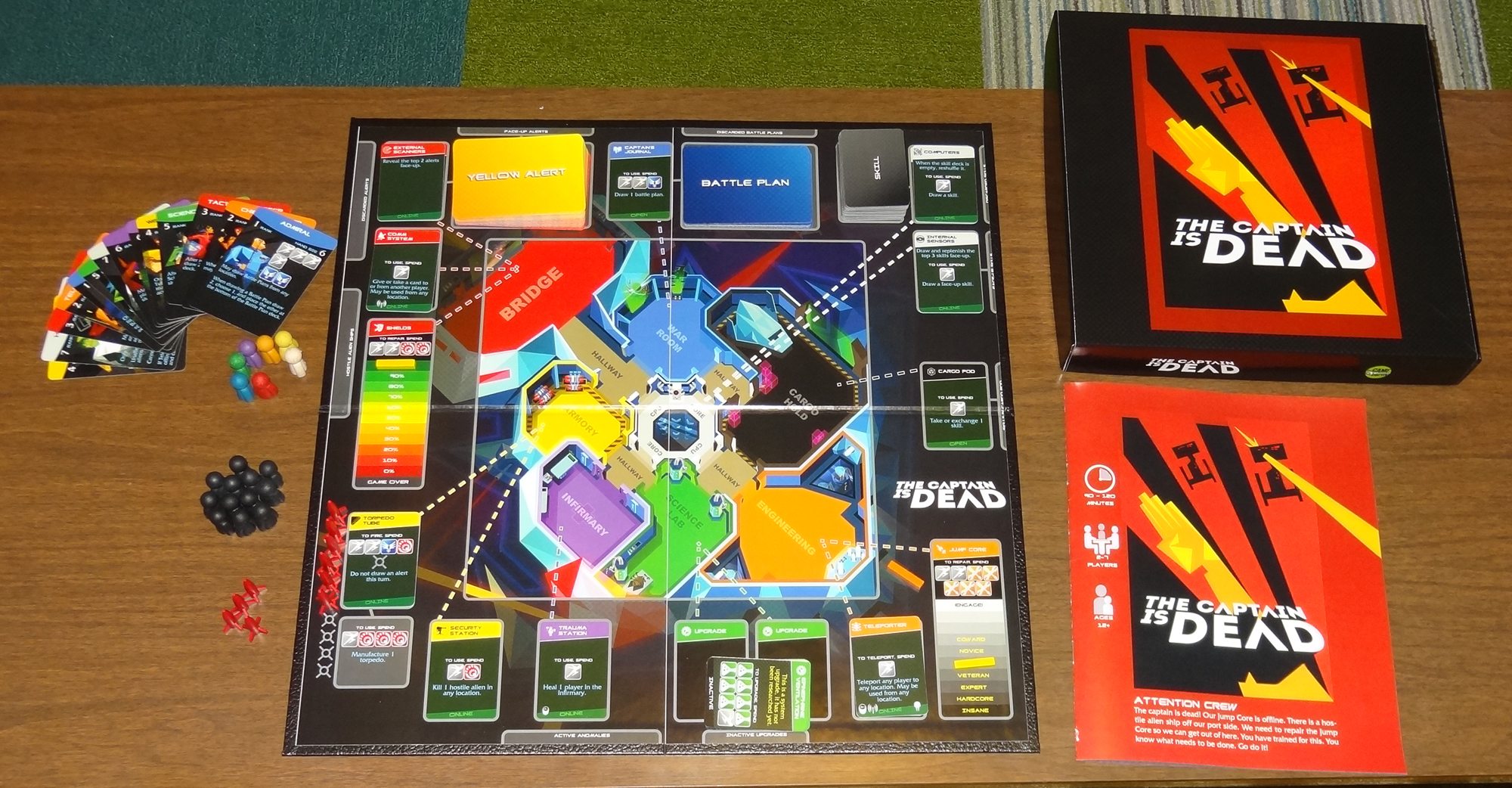
Components:
- 1 game board
- 14 Role cards
- 48 Skill cards
- 6 Ship System cards
- 5 Ship Upgrade cards
- 14 Battle Plan cards
- 24 Yellow Alert cards
- 26 Orange Alert cards
- 6 Red Alert cards
- 26 pawns (14 roles, 12 aliens)
- 3 indicator bars
- 7 torpedoes
The board is a large quad-fold board that has a map of the ship in the center, surrounded by several areas for cards that indicate the various ship systems. There are also areas on the edges of the board that show where other cards are displayed face-up or discarded. It’s a pretty nicely laid-out board that makes it easy to link the various ship systems to their physical locations on the map.
The artwork for the game, by Gaetano Leonardi, is fantastic—sharp, angular graphics that have sort of a propaganda-poster feel to them. There are 14 roles, with 2 of each color—originally the game only had 7 but the bonus characters were unlocked as a stretch goal. Additionally, originally there were just 7 colored player pawns, but another stretch goal unlocked custom pawns, so there’s a specific pawn for each role. (I suppose this means you could play with more than 7 players, but the balancing might be off.)
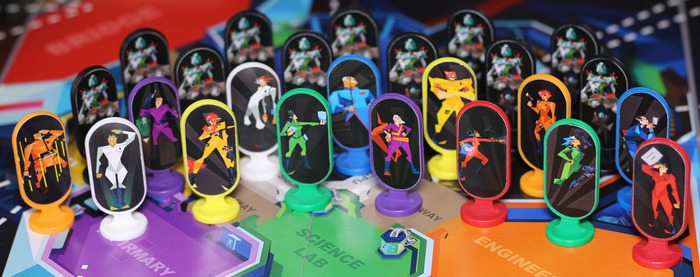
The cards are a decent quality (12pt heavy clay coated, 269gsm card stock, which is the standard for The Game Crafter), but not as glossy or snappy as what you might get from, say, a Fantasy Flight game. The Alert cards and Battle Plans have minimal graphics—mostly just text that explains what it does or how to use it.
The prototype version I played with is fairly close to the final production quality, though with some minor printing errors and typos which will be corrected in the finished game. I’d say that the overall component quality (cards and box in particular) are slightly lower than I’ve seen in games by major publishers, but the game looks really sharp and the components are still pretty nice.
How to play
The object of the game is to repair the ship’s Jump Core before you all die, which happens if you take a hit when you have no shields left or when you need to beam more aliens aboard and there are no more left in the supply.
To set up, you place all of the ship system cards on the relevant spots with the “online” side showing. (Some of the systems don’t have specific cards.) The Upgrade cards are placed near the science lab, off the board. All the Alert cards are placed in one deck, with Red at the bottom, Orange in the middle, and Yellow on top. The top two Alert cards are placed face up next to the board, since the External Scanners let you peek to see what’s coming up.

Each player gets 5 skill cards, and chooses one to place in the Cargo Hold. There are also three skill cards turned face-up next to the Internal Sensors area. The shields start at 100% (marked with a yellow bar) and the Jump Core starts on the difficulty level of your choice, from Coward to Insane. You also start with six loaded torpedoes.
Players get to choose which of the two roles they want to use for their color. For instance, the blue player gets to choose between the Admiral and the First Mate, who have slightly different abilities. Everyone starts in the room that matches their color.
Finally, once all of that is set up, you start by resolving a bunch of Alert cards—as many as there are players. These will knock various systems offline and potentially injure players.

On your turn, you’ll get to take a number of actions, based on your role. Most of the characters have 4 actions to spend, plus some skills discounts, and other special abilities. Here are the basic single actions:
- Move 2 spaces
- Kill an alien in your location
- Carry another player 1 space
- Give a skill to another player in your location
- Take a skill from another player in your location
In addition, there are various actions that can be taken on the board while you’re in those specific locations. For instance, the Computers let you draw more skill cards for one action each. The Torpedo Tubes let you launch a torpedo at a cost of two actions, plus one Command skill and one Tactical skill.

When an action requires skills, first you can see if your character has any skill discounts. The Tactical Officer, for instance, has two Tactical discounts and so she wouldn’t need to spend any cards to use the Security Station, which normally requires one action and one Tactical skill. Any skills required that you don’t have a discount for require discarding skill cards from your hand.
Here’s a list of the various stations and what they do:
- External Sensors: allows you to see 2 upcoming Alert cards
- Comm Systems: allows you to trade cards with people not in your location
- Shields: protects the ship
- Torpedo Tube: fire a torpedo to discard an enemy ship OR skip drawing an alert card; a secondary action lets you load torpedoes
- Security Station: kill a hostile alien in any location
- Trauma Station: Heal a player in the infirmary
- Science Lab: install ship upgrades
- Teleporter: Move any player to any location
- Jump Core: Repair to win the game
- Cargo Pod: Take or exchange 1 skill from the cargo hold
- Internal Sensors: Shows 3 face-up skill cards, and lets you draw one of them
- Computers: Take a skill card from the deck
- Battle Plan: Take a Battle Plan card, which is a powerful single-use ability
At the end of your turn, you’ll draw one Alert card. (If the External Sensors are online, the top two Alert cards will be face-up next to the board, and you draw the first one.) The Alert cards will do various things: knock systems offline, reduce your shields, board hostile aliens, and so on. There are also anomalies that remain in play, and alien ships that will increase shield damage until you shoot them down with torpedoes.
Most cards will have an override cost of 3 Command skills. The active player may pay this cost to discard the Alert instead of activating it. Otherwise, the damage is done.
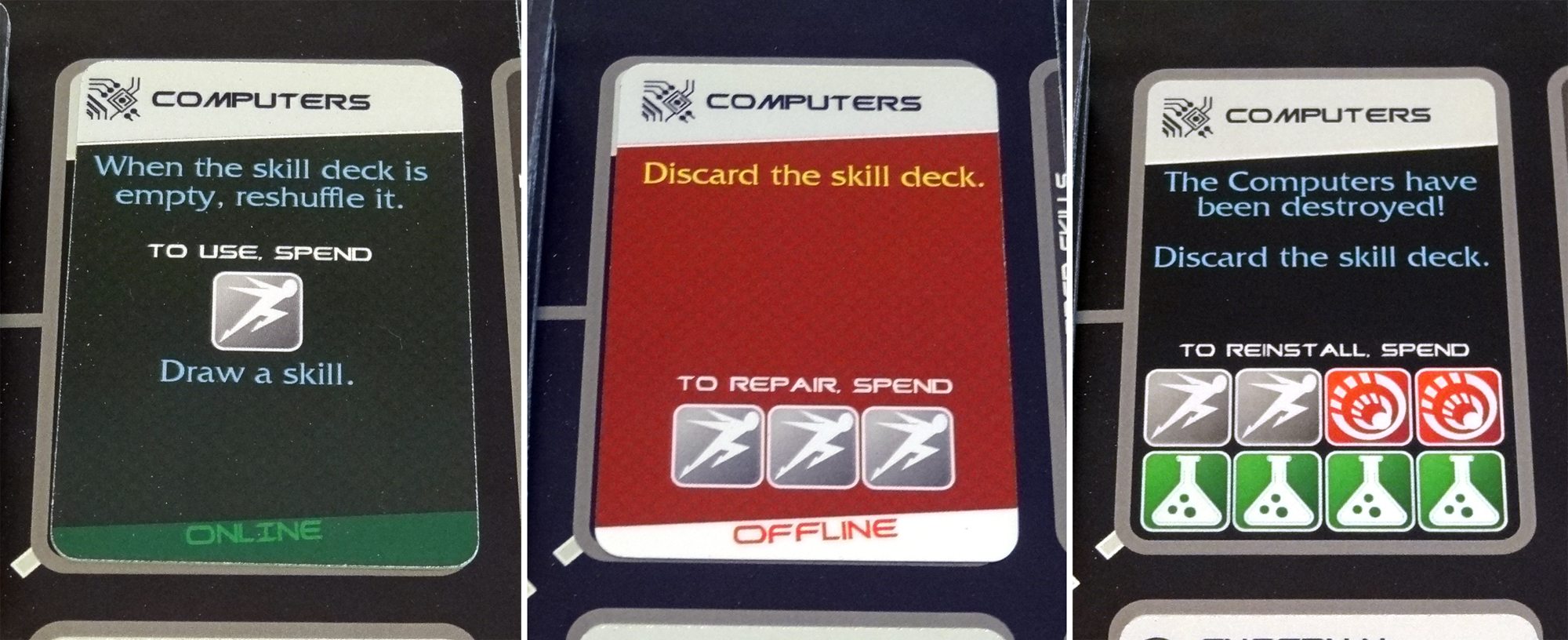
When a system is knocked offline, that system card is flipped over, and you’ll see the relevant effect, as well as the action and skills cost to repair the system. Orange Alert cards will start destroying systems instead—then the relevant card is removed from the board, and the cost to repair is greater. If a system is offline or destroyed, it can no longer be used.
Injured players are placed on their side, and they can only move, kill aliens, and use the Trauma Station to heal. If you’re in a location with an alien, then you may only kill aliens or use the Teleporter.
The Science Lab has room for two ship upgrades, which are represented by the cards off to the side of the board. If you spend the action and skills cost of an upgrade, you can add it to your ship—these can be very valuable, giving everyone an additional action, reducing the number of hostile aliens that can board your ship, improving your sensors, and so on.
The ultimate goal is to repair the Jump Core fully, moving the bar up to “Engage!” However, you’ll be running around the ship repairing other things in the meantime.
The game ends if you engage the Jump Core, or if your shields drop to 0%, or if you’re supposed to add aliens and there are no more in the supply. If you manage to survive until the Red Alert cards start showing up, you’ll probably die pretty quickly after that.
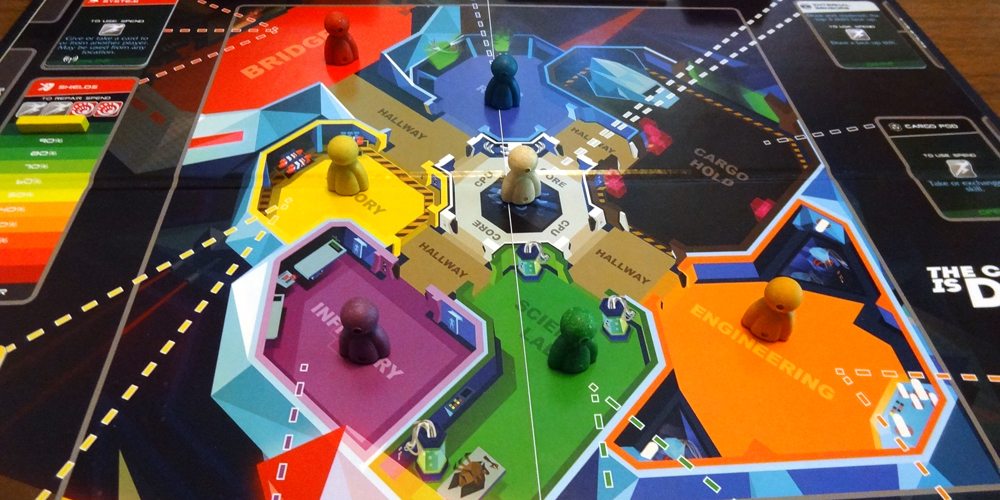
The Verdict
As far as cooperative games go, The Captain Is Dead has a fantastic theme. It’s not a totally new theme, of course: Damage Report, Space Alert, Space Cadets, and Battlestar Galactica all have some similar elements (though BSG also throws in hidden traitors). You’re on a spaceship, running around trying to put out fires while also accomplishing some larger mission. Captain may have the most similarities, theme-wise, to Damage Report, because those focus more on what’s happening inside the ship—and what’s happening is that systems keep failing and need to be repaired. But the mechanics and the feel of the game are quite different.
Designers Joe Price and JT Smith have put together a little slice of sci-fi that will seem familiar: teleporters and jump cores, scientific anomalies, hostile aliens, and so on. There are a few direct references to Star Trek in the Battle Plan cards, with some named “Make It So,” “Beam Me Up,” and (haha) “Grow the Beard,” but for the most part it’s a generic spaceship.
I’ve gotten to try the game with 3 players and with 6, though so far just on the easier levels. The difficulty level seems to scale the game pretty well. With 2 players, the anomalies don’t affect you, but otherwise the main scaling is simply that you draw an Alert card at the end of each person’s turn. So with more players, you have access to more different abilities, but there are more disasters that happen between your turns. Also, the more players you have, the more Alerts you’ll draw during setup, so the worse off your ship is when you start the game.
The Anomalies can be really tricky—Irrational Fear prevents you from using or repairing anything unless somebody is with you, and Irrational Anger is the opposite: you can only do these things when you’re alone. The Fear anomaly is tougher if you have fewer people spread out throughout the ship, but Anger would be harder in a 7-player game when you’re constantly in the same room as somebody else.
I do like that each color gets a choice of two roles, but it felt like there still may be a slight advantage to the original set rather than the added set. More plays are probably necessary to know for sure, but we spent a lot of time just trying to repair the Computer and Teleporter so our Hologram player could still move around the ship.
I do have a few concerns for replayability: adjusting the difficulty level of the game is essentially picking how many times you’ll need to repair the Jump Core before you win, so the mission of the game is always the same. Certainly it will feel a little different based on the combination of roles you’re using and the exact order of the Alert cards, but the overall timing will be similar: after so many Yellow Alerts (which knock systems offline and damage your shields) then you start getting the Orange Alerts (which can destroy systems and do even more damage), and then the Red Alerts, which will finish you off within 6 turns, max.
The other issue, common to cooperative games, is the alpha player problem. In a game that feels like solving a puzzle, an outspoken player can take over the play and end up directing everyone else. I think the title of the game itself is supposed to be a hint that nobody is actually in charge, but depending on your gaming group it can end up feeling like everyone is watching one person play. Ideally you should know your group well enough to judge if this will be an issue. I did play this with my kids (ages 7 and 10) and they understood the rules but found it just slightly complex. So it’s playable with younger than 12, though in that case expect to be the alpha player or at least give reminders on how various ship components work.
If you can manage the alpha player issue, The Captain Is Dead can be a blast to play. Even though it’s turn-based rather than real-time, there’s still real tension that builds up when you’re sitting there looking at the attacks that are coming and realize that you have to choose between shooting a Torpedo or getting another Battle Plan. If your idea of a good time is to spend an hour or two on a disaster-prone spaceship, this is the game for you!
I haven’t played the other two games in The Game Crafter’s Kickstarter campaign—Scarborough Fair and Turbulence—but I’d recommend giving The Captain Is Dead a closer look. For more about the games and to pledge for a copy, visit the Kickstarter page.
Disclosure: The Game Crafter provided a demo prototype of The Captain Is Dead for review.
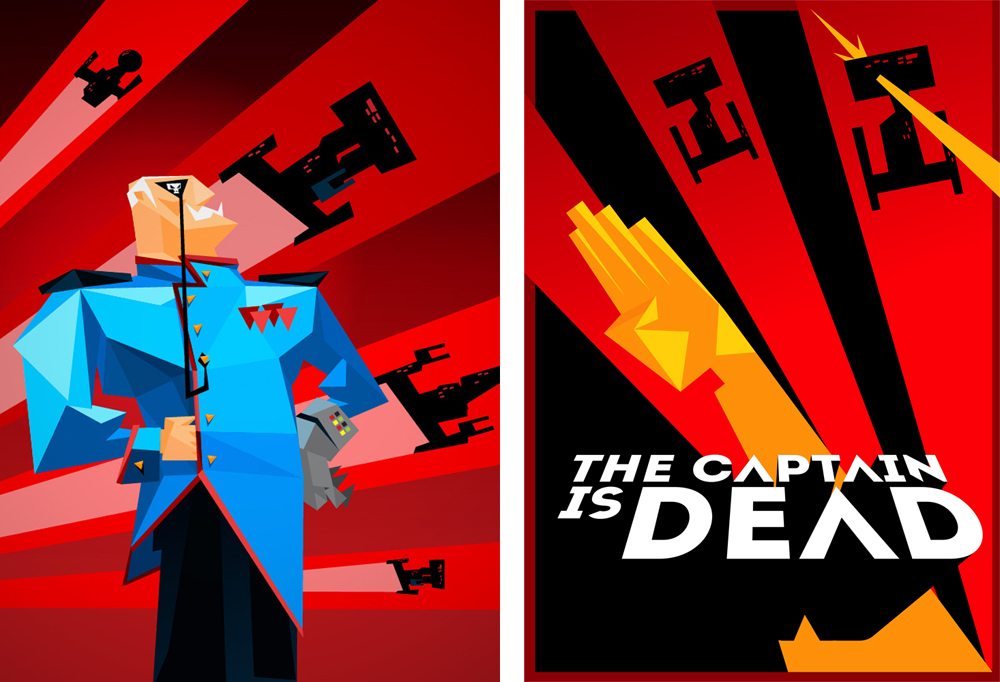


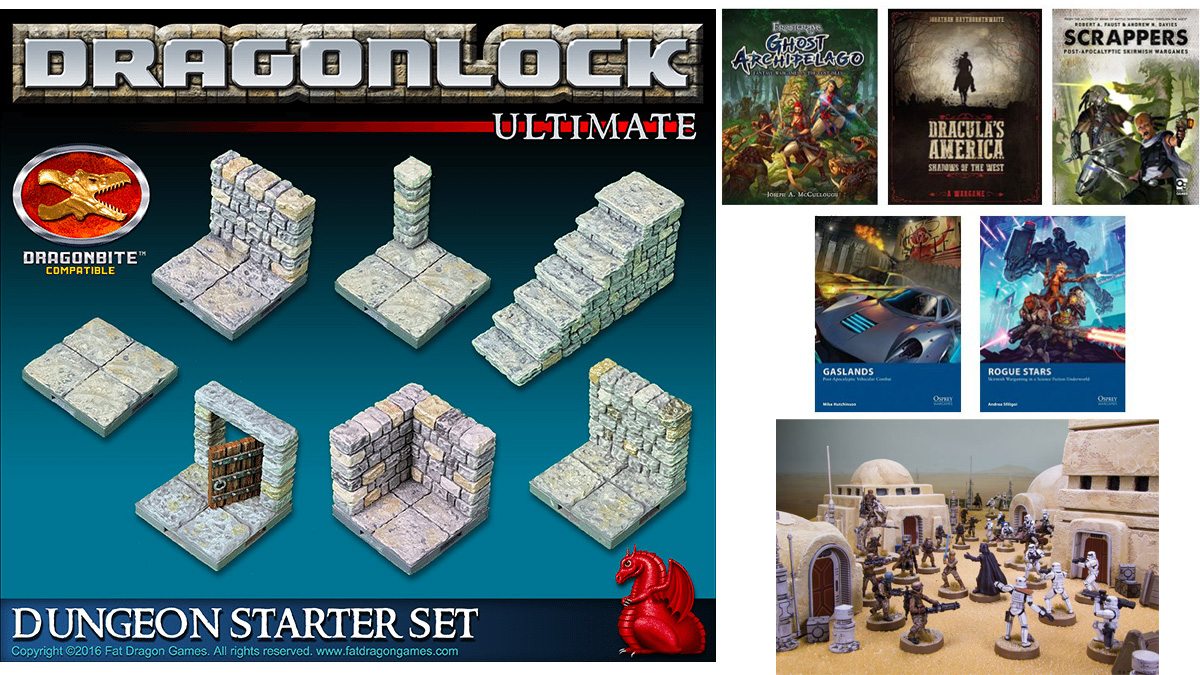
I’m not sure if you’ve mention this one, but their is a cool Ice Age Mammals KS in the last 24 hours.
https://www.kickstarter.com/projects/dinaandrewswalker/miniature-ice-age-mammal-adventure-set
Their page is a big confusion, but I grilled the creator in the comments and got this breakdown:
$15 – Any 1 mini from the set + Freebie SGs (7 minis)
$20 – T-shirt + Freebie SGs (6 minis)
$25 – Any 2 minis from the set + Freebie SGs (8 minis)
$30 – Any 3 minis from the set + Freebie SGs (9 minis)
$60 – Any 5 minis +1 Base SG + Freebie SGs (12 minis)
$80 – The 8 mini set + both Base SG + Freebie SGs (16 minis)
$125 – Everything in $80 pledge + TWO of each Epic SG + tshirt (24 minis)
Still a couple more to unlock. I’m not a huge fan of the illustrations, but the sculpts we’ve seen look great.
I am glad to see The Game Crafter publishing some games on Kickstarter! They have been such an influential group in the game design/development community (I have used their services for game prototyping about fifteen times now) and its cool to see this!